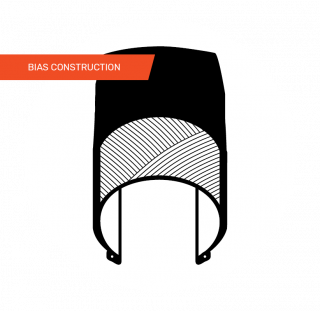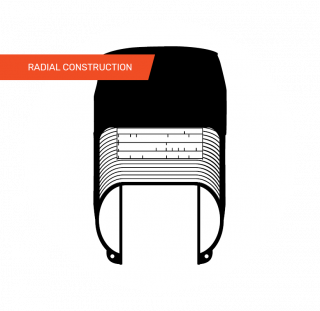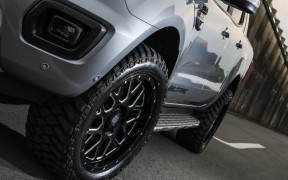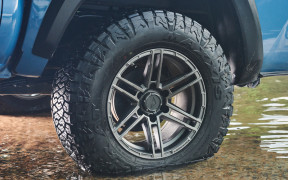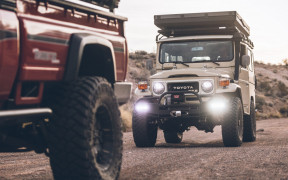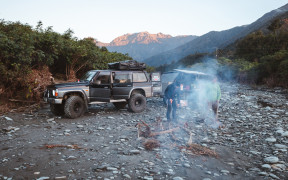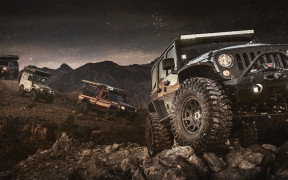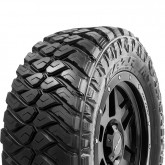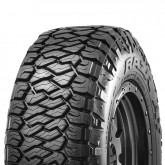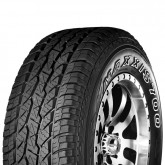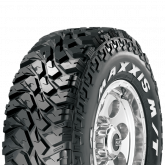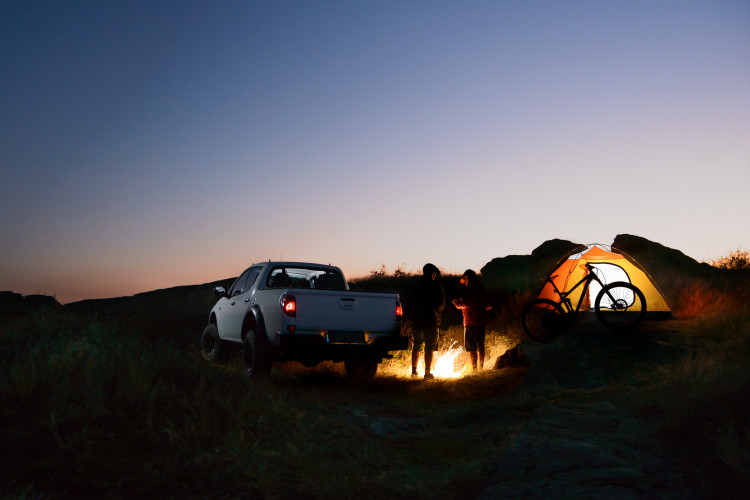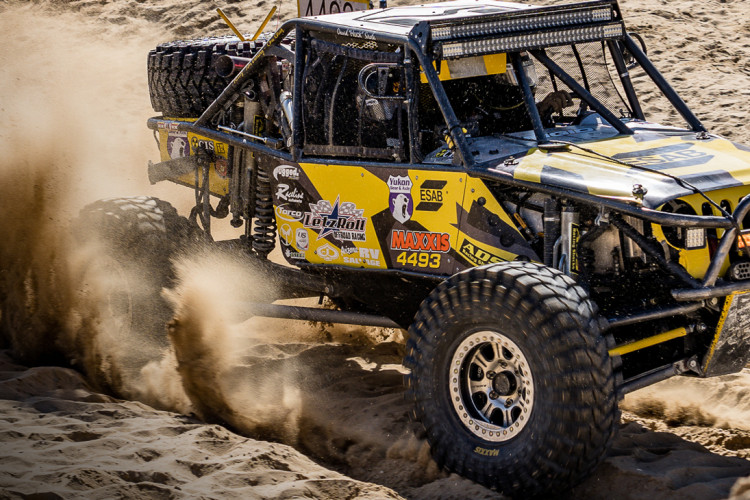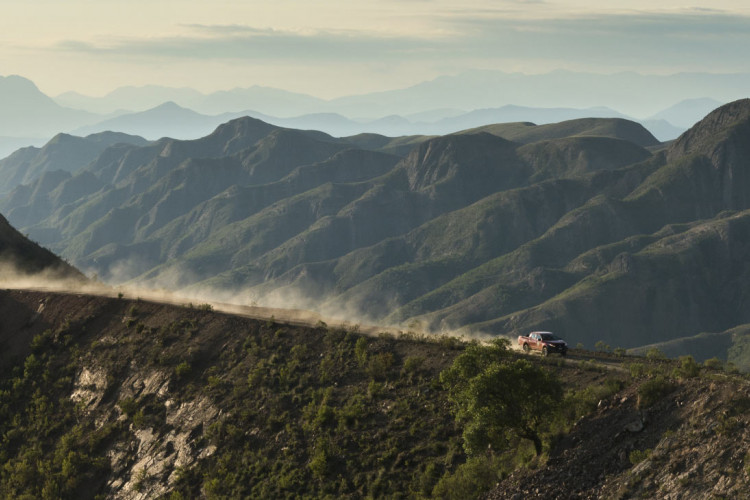
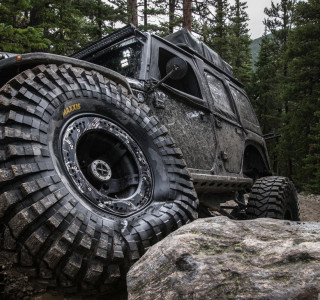
Your Guide to 4x4 Tyres
So you’ve finally got yourself the 4x4 you dreamt of. All of those dreams of the great outdoors... camping by the lake... red tartan rugs and old wicker picnic baskets, full of fresh food from the farmers market. The possibilities are endless. But there’s a problem. You need new tyres. Yup - your new best pal needs some new rubber. So what do you do? Well...reading on will be a good start.
4 Types of 4x4 Tyres
Your first job is to narrow the field down. That means deciding on the type of 4x4 tyre you need. They come in 4 basic flavours. The difference between them really being what you want them to do. Do you need them to hot tail down the highway on a regular basis or are you planning to head out to the back country and leave the tarmac behind? Or are you unsure and think you want the best of both worlds? One way to look at it is to try and estimate the time you’ll be spending on-road vs off road. That’ll give you a good read on what you need. However, let’s go into a little more detail before any decisions are made.
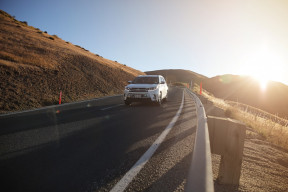
If you're all about the highway travel then you'll need a highway 4x4 tyre. It'll be better suited to the heat buildup from travelling at speeds and so much quieter. You'll be able to deal with a bit of sand ok with this type of tyre but don't expect to go off-road proper. You'll get stuck.
Pros
Stability at higher speeds
Better traction in wet conditions
Quiet
Cons
Not really suitable for off-road
Not as cool as a chunky tyre
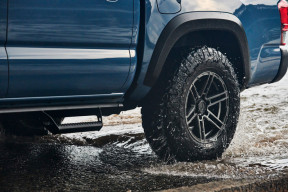
Behold the swiss army knife of the tyre world. The AT tyre tries to do a both of everything...and most of them can. Take the Award Winning Maxxis AT700 Bravo for example...it’ll have you crossing from the bitumen to the back blocks with no issue. So, if you think you need something to take you off-road but not into the serious mud, then an All Terrain is for you.
Pros
Do a bit of everything
Looks pretty good
Cons
Versatility has a cost and means not as good as a highway tyre on-road, or a mud tyre off-road
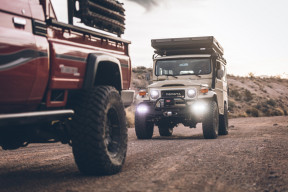
Ready to get dirty? Good. You’ll be needing a mud tyre. If you think you’ll be spending more time off road and in the dirt than you will on-road, you need a tyre that can deal with the rough stuff. These are made to be tough and withstand a good degree of punishment. They look pretty good too.
Pros
Great traction in mud
Built strong
Aggressive looks
Cons
Can be loud on the highway
Ride can be a bit rough on tarmac
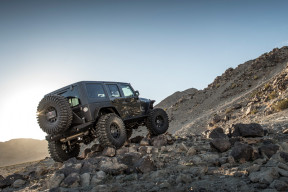
If you don’t know what these are then you don’t need them. These are for serious action and 4x4s that have been adapted for the conditions. Just ogle them lovingly from afar.
Pros
Built purposely for tough 4WD action
Cons
Not really suitable for anything else
There are some commonalities amongst most 4WD tyres. They are generally built stronger than normal tyres, making them more suitable for heavier loads. They also tend to have increased puncture resistance and extra strength in the sidewalls. So while we’re talking about, let’s take a closer look at how they’re made...
4x4 Tyre Construction
You’d expect a 4x4 tyre would be made radically different from a standard car tyre. But...well...not really. They just tend to be larger and heavier. Construction is pretty much the same, with radial plies.
That does change with the extreme mudders though. These bad boys have a bias ply construction. What does that mean exactly? It means you can deflate them and run at very low pressure. This enables them to literally mould over obstacles. However, on the road at standard pressures they have quite relatively low speed ratings.
4x4 Tyres - What are they good for?
You probably opted to buy a 4WD for a variety of reasons. You might have wanted the extra space they typically have. The extra height might be appreciated. Something to tow the boat or trailer. Or something to load up and carry heavy loads. Whatever the reason...there’s a few possibilities they open up. And the right set of 4x4 tyres can have a big impact on what those possibilities are. Of course, there’s the needs of work. If you’re in construction, forestry, farming or something else that requires a 4WD, then you probably already know all about 4WD tyres. Either that, or you don’t have to think about it as the company ute comes with tyres on it.
Outside of work...that’s where the real fun begins. It’s no wonder the Ranger and Hilux are amongst the top selling vehicles in New Zealand every year. We live in a country that’s perfect for such metal beauties.
One thing is for sure... where the road ends is where the real beauty of New Zealand begins.
It might be a trip to the family batch which means leaving the tarmac behind. The annual visit with the rellies that live on a farm in the middle of nowhere, down a long and bumpy farm road that’s better suited to a tractor or quad bike. Or it could be you just want to load up the tent and sleeping bag and get away from it all for a few days. One thing is for sure...where the road ends is where the real beauty of New Zealand begins. Ours is a special place. A 4WD helps us take in more of it. So - what do you need a 4WD for? You need one to explore our homeland. Think about this a bit and it’ll help guide your choice of tyre.
4x4 Tyre Tips
-
How much should a 4x4 tyre cost?
Now this is a big question. You can pick up a set of cheaply made All Terrain tyres in a common size, say 15”, for about $180 a piece. A quality All Terrain tyre in 265/65R17 starts at about $300. A decent mud tyre in the same size is likely to be more like $450 an upwards. Want a proper mud beast for extreme action? A 40x13.50-17 will set you back at least $900. Like all things, it depends on what you want. Just consider this though...you’ve gone to all the expense of purchasing a 4WD so why inhibit the single biggest advantage of a 4WD by plopping rubbish rubber on it? You wouldn’t load up your backpack and get ready to go bush, then stick a pair of old jandals on your feet...would you?
-
Can I replace just two 4x4 tyres?
Generally speaking, it’s not a good idea. If your two other tyres are half worn, you’ll risk damaging your transmission by effectively running tyres of different dimensions. Sure, it might be ok on a 2WD but it’s not a good idea on a 4WD. Instead, change all four and then rotate regularly. That way you’ll ensure they wear as evenly as possible.
-
Are expensive 4x4 tyres better?
A better quality tyre will give you improved highway handling, self-clearing and longer tread life. A low quality (cheap) tyre will make more compromises. These are typically in highway handling and noise. That said, a higher price doesn’t always mean higher quality. Beware of very expensive tyres that make claims about extra long tread life. You’ll find high quality but competitively priced tyres, such as those on offer from Maxxis, will likely give you a better cost per KM.
-
How much load should a 4x4 tyre carry?
Again, this can vary significantly. A passenger rated 4x4 tyre might have a load rating of 96 (710kg) in a size to suit a Suzuki Jimmy. A relatively standard 10ply 4x4 tyre will be good for up to 120 (1400kg) or 121 (1450kg).
-
Do you need the extra load capacity?
Only if you need it. That said, even if you don’t think you’ll need it now you might in the future The beauty of owning a 4WD vehicle is putting it to use. You might not think you will but often just because you can often means you do.
-
Can I deflate my 4x4 tyres for better off-road performance?
Oddly enough, we’ve not found a manufacturer that recommends it. That said, we’ve also not heard of too much going wrong when it’s done. That is, as long as you only drive at low speeds and the pressure doesn’t go below around half of what the recommended pressure for highway speed is. We do have to stress this though: only do it if you have a pressure gauge and compressor. You need to get the pressure back up before hitting the road. Driving at highway speeds on underinflated tyres is extremely dangerous and you risk losing control of the vehicle. If you don’t have any way to inflate your rubber back to recommended pressures before hitting the tarmac, don’t let them down.
What should I look for in a 4x4 tyre?
Ok, so we’ve talked a little about the types of 4x4 tyres you can get and their differences. But what about the specific qualities of the tyre? What should you be looking for exactly?
Self Clearing Tread
Good 4x4 tyres are designed to be self-clearing. That is, they’ll spit out mud and stones from the tread. Doing so means the tread is clean and clear to help churn through more difficult situations. So look for tread block designs which have the lugs tapered slightly inwards, towards the edge of the tyre. This opens a broad channel for the mud to escape. If you’re not sure, ask your friendly tyre expert how well the tyre self-clears in mud.
Quiet Road Running
Highway and All Terrain tyres tend to be relatively quiet. But mud tyres are a different beast. They are renowned for a tell-tale hum on the open road. With some tyres this can be bad enough to drown out your tunes, penetrating your head with a constant and annoying drone. So, if you value your sanity look for irregularly spaced tread blocks. There’s more though, with new technology in emerging tread designs which dampen the sound right down. The best we’ve come across for noise suppression in a mud tyre is the Maxxis RAZR MT.
Stone Deflectors
These are tiny ridges between the tread grooves that throw out stones which would otherwise lodge in the tyre, eventually working their way through the tread to create a puncture.
Siped Tread Lugs
A key factor in good highway performance and well worth checking the tread for. Siped tread lugs looks like tiny grooves in the tread blocks and they do a champion job of draining extra water away on wet roads. For added traction in the rain, they’re well worth it.
Gravel Performance
Two things to consider if you’re doing a lot of gravel work: handling and tread life. Very fine tyre treads may cut up badly on rough surfaces. A good quality All Terrain tyre should be fine. As always, if in doubt don’t be scared to ask your local tyre person about gravel performance. The more specific the questions you ask, the better information you’ll get so you can make an informed decision.
Puncture Resistance
You’ll definitely want to ask about this one. Especially as some tyre manufacturers will claim they add more tread or bulk to resist punctures. Doing that can actually just make the carcass a lot stiffer, which actually makes the tyre easier to puncture. Think of it this way...a fully inflated balloon is always a lot easier to pop than one that is under inflated and can flex to absorb sharp edges.
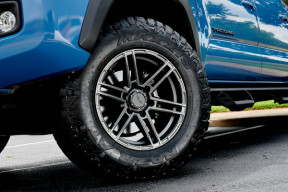
Getting 4x4 tyres fitted
Most tyre dealers who fit car tyres can also handle 4x4 tyres. The exception being very heavy 4x4 tyres which can be too heavy for some wheel balancers. If you’ve purchased some very heavy tyres and your tyre shop is having trouble then this could be why. Chances are though - you’ll be getting the tyre fitted at the same place you buy them so should be perfectly ok.
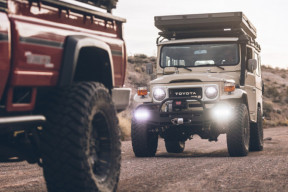
Should off-road tyres be balanced?
They should. The benefits of a balanced tyre include even tread wear and reduced vibration. But...if you’re heading off-road regularly and doing some real extreme stuff then your tyre is going to slip around the rim a little, so balancing will be a waste of time. Rule of thumb - if you're doing any amount of highway driving, get them balanced.
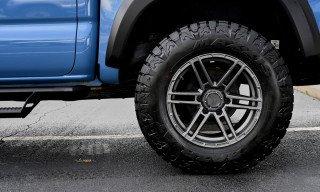
Caring for your 4x4 tyres
Keep them clean
Making sure they are free from rocks and suchlike means the tread is free to do what it is designed to do...grip. Plus an aggressive looking 4x4 tyre can look mighty fine.
Rotate them
A decent set of bad boy 4x4 tyres comes with a decent price, so get the most out of them by rotating regularly for even tread wear.
Tyre Pressure
Same as all tyres really. Keeping them at the proper pressure means they'll perform better and last longer.
Wheel Alignment
A key factor in good highway performance and well worth checking the tread for. Siped tread lugs look like tiny grooves in the tread blocks and they do a champion job of draining extra water away on wet roads. For added traction in the rain, they're well worth it.
Which 4x4 Tyres do you need?
Back to the beginning - you’ve got a nice new 4WD and its needs some new rubber feet. What do you do? Well, it ain’t rocket science. Spend all the time on the highway, go for highway tyres. Mix it up with a bit of off-road? Then All Terrain tyres are for you. Spend most of the time off road and need to get through the mud? Mud tyres will be good for that. Are you an extreme 4WD junkie? Well...erm…extreme 4WD tyres might just be for you.
The only overriding factor to the above is when it comes to looks. In which case, ignore logic and go for something that looks good on your vehicle. Just be aware of the concessions you may have to make.
Whatever type of 4x4 tyre you do decide on, just make sure you choose a quality one. You really do get what you pay for. Although sometimes you can pay more for what you get. So do your research and make an informed decision.
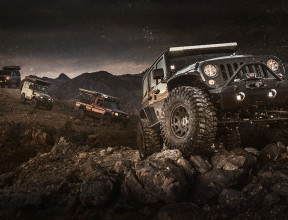
Got your dream 4x4?
Check out our wide range of 4WD tyres and find the perfect fit for you.
4x4 Tyres We Recommend
Maxxis MT772 Razr MT
The tyre with the cult following. The Razr is an untamed beast - rocks and boulders try to get out of its path and the tarmac holds it breath when a Razr travels on it. This tyre goes where it pleases.
Available in a range of sizes and prices
$538-926
Find out moreMaxxis AT811 Razr AT
Maxxis' newest All Terrain. Fabulous on the highway. Insane off it. This is an All Terrain that will surprise you at how far you'll get… and how much you'll enjoy getting there.
Available in a range of sizes and prices
$396-906
Find out moreMaxxis AT700 Bravo AT
From the supermarket to the secret fishing spot, the AT700 handles tarseal, gravel and dirt with ease. Good off-road capability with great highway performance. 2019 4x4 Australia All Terrain tyre of the year.
Available in a range of sizes and prices
$478
Find out moreMaxxis MT764 Bighorn MT
A tyre that simply loves the dirt and mud. This is that extra tough tyre and feels naked without a thick layer of mud on its sidewalls. Search for the dirt and then drive into it, through it and out the other side.
Available in a range of sizes and prices
$349-670
Find out more